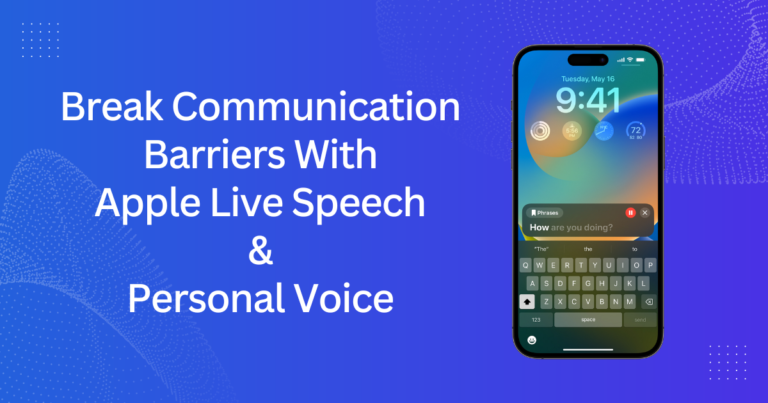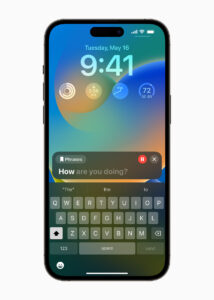
Breaking Down Communication Barriers with Live Speech and Personal Voice
Many individuals struggle with communication due to disorders such as Autism, ALS/MND, Down’s Syndrome, cerebral palsy, or speech impediments. Finding an appropriate AAC tool to express themselves can be challenging. Yet, innovations such as Apple’s Live Speech and Personal Voice have helped to advance the technology for those that are non-verbal. The integration of these features into the leading AAC application Speech Aid, a prominent text-to-speech app, is a significant stride towards achieving seamless and natural sounding communication for non-speaking and non-verbal individuals.
Live Speech: A Text-to-Speech AAC Revolution
Imagine not being able to voice your thoughts and feelings freely. Now, imagine a tool that allows you to type what you want to say and then speaks it out loud for you during phone conversations, FaceTime calls, or even in person face-to-face interactions. This is what Apple’s Live Speech feature promises, at a very good but basic level from your Apple device, allowing individuals to overcome their speech barriers and participate actively in conversations.
Let’s consider a real-life scenario with Alex, a teenager diagnosed with Autism. Although he is non-verbal, Alex has a lot to say. His parents have tried numerous AAC apps to help Alex communicate, but nothing seems natural or intuitive enough. Enter the Speech Aid app with an integrated Live Speech feature. Alex can now participate in family conversations, express his feelings, and most importantly, make his voice heard. This interaction paints a clear picture of how technologies like Live Speech can significantly enhance the lives of non-speaking individuals when used with Speech Aid.
Personal Voice: Text-to-voice that really is a Speech Aid

Next, let’s talk about Personal Voice. This feature is truly a game-changer for those that at risk of losing their ability to speak. With Apple’s new feature Personal Voice, users can record a short session of their own voice, which is then synthesized to create a unique, personal voice for the user. This synthetic Personal Voice can be used in Speech Aid by selecting it as the voice of choice, providing an incredibly personal and emotionally familiar method of communication.
Consider Lisa, she has recently been diagnosed with ALS. Lisa knows that she may gradually lose her ability to speak. But with Personal Voice, she can ‘bank’ her voice, preserving her unique vocal identity, something that brings her immense emotional comfort. What if Lisa could use this unique voice with her preferred AAC app, Speech Aid? Well, that’s precisely what’s on the horizon, as Speech Aid will give its users the option to use their Personal Voice, offering a more personalized and emotional form of communication by using their own voice.
Speech Aid: A text-to-speech app with Live Speech and Personal Voice
With so many AAC apps, Speech Aid stands out as the one that has been designed specifically for those with speech impairments. Designed specifically for non-speaking individuals with conditions like autism, ALS/MND, cerebral palsy, and more, Speech Aid turns typed text into spoken language, offering a lifeline of communication. Its intuitive interface, ability to save frequently used phrases, the option to view phrases in a grid layout, and customization options set it apart, making it a go-to choice for so many and recommended by so many health professionals.
By incorporating Apple’s Personal Voice feature, Speech Aid is stepping into a future where AAC is not just about facilitating communication but also about maintaining the individuality of its users. Imagine being able to communicate in your own voice, participate in lively conversations, and express yourself with no barriers. This is what using your actual voice via Apple’s Personal Voice feature on Speech Aid will do.
F.A.Q (Frequently Asked Questions)
1. What makes the integration of Apple’s Live Speech and Personal Voice features unique in an AAC app like Speech Aid?
Speech Aid has always had the Live Speech feature as the core of its functionality, but the addition of the Personal Voice feature in Speech Aid will give its users the ability to not only turn their typed text into spoken language but to do so in a voice that sounds like their own. This provides the non-verbal community with a significant emotional connection and a sense of identity that many text-to-voice AAC tools do not offer.
2. How does Apple’s Live Speech feature benefit non-verbal individuals with autism and other conditions?
Live Speech transforms typed text into spoken words, enabling individuals with ALS/MND and other conditions to voice their thoughts and feelings, which may otherwise remain unexpressed. This feature that the Speech Aid app has always done, but with so many more features than what the Apple feature provides as Speech Aid has been designed with a fully comprehensive feature rich app that includes a grid layout for users with conditions such as children with Autism.
3. How does Apple’s Personal Voice feature work with Speech Aid for those at risk of losing their speech?
Personal Voice allows individuals, especially those at risk of losing their speech due to conditions like ALS, to create a synthetic voice that resembles their own. This voice can then be used with the Speech Aid app by selecting the user’s voice from its list of voices within the app’s settings. This offers a highly personalized and emotionally connected communication experience for its users with many other features that those that are unable to speak will need.
4. Why is Speech Aid recommended as a go-to AAC app for non-speaking individuals?
Speech Aid is a text-to-speech app that stands out due to its intuitive design, the ability to save frequently used phrases, a user-friendly layout, the choice of languages, the option for a grid layout and the integration of Personal Voice selection. These features make it a highly recommended tool by healthcare professionals for enhancing communication for individuals with speech impairments.
5. What potential impact does the integration of Live Speech and Personal Voice in Speech Aid have on the AAC field?
Speech Aid has always done live speech as a text-to-speech app but the integration of the Personal Voice feature is game changing and signifies a major advancement in AAC technology. It allows non-verbal and non-speaking individuals to communicate in a voice that closely mirrors their own, by setting up their voice during a time they are still able to speak. Personal Voice will be the users voice that is saved and used with the Speech Aid app to speak, adding a personal touch and enhancing the overall communication experience.